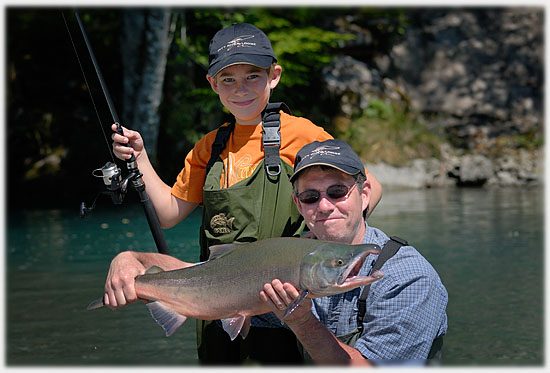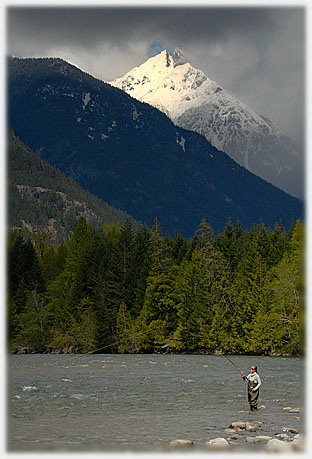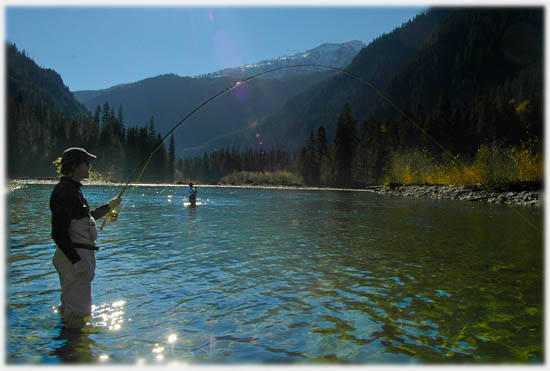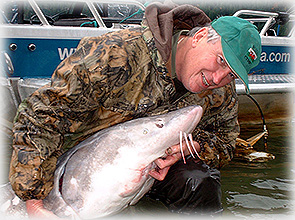Fly Fishing in British Columbia Tackle Tips. When planning a fishing trip, half the fun is looking through gear and deciding what might be the most appropriate to use on the trip. Picking up an old rod and envisioning a new fish on the end of the line is often the first bit of excitement of the trip. On the Pitt, because of the sheer diversity of fish we use a variety of different gear depending on what season you are here in and what we will target that day.
 Clothing: Although we have waders, boots, lifejackets and some fishing jackets it is a good idea to bring warm clothes with you no matter what time of year you come.
Clothing: Although we have waders, boots, lifejackets and some fishing jackets it is a good idea to bring warm clothes with you no matter what time of year you come.
Sweaters (preferably synthetics and wool–cotton becomes very cold when wet) are a necessity, long underwear and warm socks as well. A waterproof rain jacket is always a good idea and gloves (neoprenes are best) help with cold fingers. Although you will receive a Pitt River Lodge hat, it is recommended that you bring a warm toque. Sunglasses are important (especially when fly fishing) and a wide brim cap will shelter you from the sun. Sunscreen is always important in the summer months and fortunately, you don’t have to worry about bugs too much on the river.
”By mid July, everything in the Pitt River Valley universe comes into alignment”
From Early June until mid September all the Salmon are running and all the trout flood the river to gorge on the nutrient rich Salmon eggs. This time of year an egg pattern nymphed will not go untouched by trout and both Salmon and Trout can be taken on a flashy-fly or leech pattern. To bring one smaller rod and one larger rod is recommended.
•6-7 weight rod for the Trout (set up with a floating line for nymphing eggs)
•8-10 weight rod for the Salmon and larger Trout (With interchangeable sink tips if possible, a heavy sink tip is often used for Salmon in the deeper pools.
•Heavy tippet material for Salmon is required: 10lb test – 20lb test
•Light tippet material for the Trout: 6lb test – 10lb test
•Flies: Gorman Eggs(or any egg pattern), Minnow Patterns, Egg Sucking Leeches, Leeches, Articulated Flies, Intruders, Weighted Flies, Spey Flies, Nymphs
”One of the most colourful and beautiful seasons on the Pitt for landscape, fish and wildlife”
 Beginning in the summer and ending in late fall the Salmon are in the river and so are the trout. Much like in the Summer, bringing one smaller rod and one larger rod is recommended. Fall is the best time to fish a dry fly as the trout can be keyed into the hatches at that time of year.
Beginning in the summer and ending in late fall the Salmon are in the river and so are the trout. Much like in the Summer, bringing one smaller rod and one larger rod is recommended. Fall is the best time to fish a dry fly as the trout can be keyed into the hatches at that time of year.
•6-7 weight rod for the Trout (set up with a floating line for nymphing eggs, fishing minnow patterns or dry flies)
•8-10 weight rod for the Salmon and larger Trout (With interchangeable sink tips if possible, a heavy sink tip is often used for Salmon in the deeper pools.
•Flies: Flashier flies such as Christmas Trees work well for the Coho or Silver Salmon which run in the fall. Gorman Eggs, Minnow Patterns, Egg Sucking Leeches, Leeches, Articulated Flies, Weighted Flies, Spey Flies, Nymphs
•Dry Flies: Orange Stimulator, Stonefly, Sedge, Beetle
“The Pitt River Steelhead: The cleanest and most stunning Steelhead Strain in British Columbia”
During the winter months resident trout, late Coho (Silver) Salmon, and Early Steelhead are on the radar. The water turns from a turquoise glacial colour to absolute gin-clear runoff. Again one large rod and one small rod are recommended.
•5-7 weight rod for resident trout equipped with sink tip line
•8-10 weight rod for Salmon and Steelhead with floating line and sink tip line
•Light tippet for trout is used: 6lb test – 10lb test
•Lighter tippet is also used for Salmon and Steelhead (considering the clarity of the water): 8lb test – 15lb test
•Flies: Gorman Eggs, Minnow Patterns, Egg Sucking Leeches, Leeches, Articulated Flies, Weighted Flies, Spey Flies (Red and Orange are most productive), Nymphs
“Steelhead are in the river, anadramous trout begin to return and the resident trout become more aggressive to compete with returning species”
In the spring the fishing is very different than that of any other season. The Steelhead are in and for the trout it’s survival of the fittest.
•5-7 weight rod for the Trout (with a floating line and attachable sink tip if possible)
•8-10 weight rod for the Steelhead (with a floating line and attachable sink tip if possible Because the water is still clear a lighter tippet is recommended: 6lb test – 10lb test for trout and 8lb test – 15lb test for Steelhead
•Flies: Gorman Eggs, Minnow Patterns, Egg Sucking Leeches, Leeches, Articulated Flies, Weighted Flies, Spey Flies, Nymphs
•Dry Flies: Orange Stimulator, Stonefly, Sedge, Beetle
Cuthroat and Small trout fishing:
 •4-6 weight rod is desirable (anything larger may be too much for the fish)
•4-6 weight rod is desirable (anything larger may be too much for the fish)
•A floating line with interchangeable sink tips is desirable (We most commonly use a floating line or an intermediate sink tip for Cutthroat)
•Small flies such as Leeches, Fry and Minnow Patterns, Dry Flies(Stimulators, Sedges), Small Nymphs and Gorman Eggs
Most small trout are taken near the surface fishing a fast retrieve on a small fly.
It is also common to get them nymphing with an egg or small nymph. This requires a floating line and long leader, fished with or without a strike indicator.
Speyfishing: “The Pitt is the perfect match for a Speyrod, being able to fish the opposite bank with little effort has its rewards”
Even if you’re just starting out, bring your double hander with you! We have guides with a range of Spey casting experience including the renowned champion caster and instructor Francois Blanchet. Any rod size will do, from a six weight to an eleven weight we can give you instruction and if you don’t have your own we will equip you with one here! Interchangeable sink tips are desirable especially a fast sink tip. Bring your Spey flies too (orange and red for Steelhead especially).
The Upper Pitt River has variety of water conditions and fish species as it is a costal river close to the ocean and all runs of Pacific Salmon, Trout, Bull Trout and Dolly Varden. The water conditions vary from winter – early spring crystal clear to a glacier runoff green-blue colour late spring summer to a late fall rain runoff peat coloured river. These changing river conditions with the different runs of fish make fly choices sometime difficult and generally we fish large flies (up to 5 inches long). But don’t forget to pack some of your favourite dry flies as we do get some dry fly action in the summer and fall.
The Pitt River holds an ancient and mighty strain of Sturgeon that were almost undiscovered until recently. We take you out in our new Pitt River Lodge, ThunderJet jetboat to fish for Sturgeon so you are sheltered from the elements and have the luxury to sit down in a comfortable chair and relax between fish. Using big Tuna rods, 150lb test and bait beer is often a necessity on a Sturgeon expedition!

Nice Sturgeon